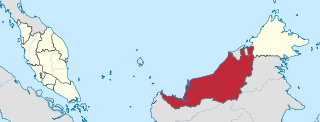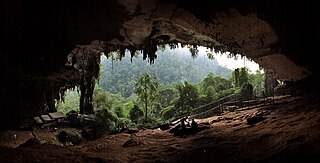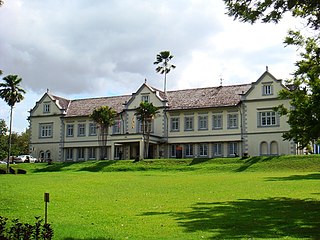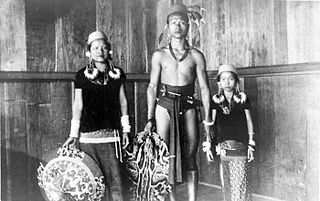This article relies largely or entirely on a single source .(November 2020) |
Alo Malau is Heaven in Asian mythology. In the beliefs of the Kenyah of Borneo, it is where they go after death to be with their ancestors. [1]
This article relies largely or entirely on a single source .(November 2020) |
Alo Malau is Heaven in Asian mythology. In the beliefs of the Kenyah of Borneo, it is where they go after death to be with their ancestors. [1]

Borneo is the third-largest island in the world and the largest in Asia. At the geographic centre of Maritime Southeast Asia, in relation to major Indonesian islands, it is located north of Java, west of Sulawesi, and east of Sumatra.

Sarawak is a state of Malaysia. The largest among the 13 states, with an area almost equal to that of Peninsular Malaysia, Sarawak is located in northwest Borneo Island, and is bordered by the Malaysian state of Sabah to the northeast, Kalimantan to the south, and Brunei in the north. The capital city, Kuching, is the largest city in Sarawak, the economic centre of the state, and the seat of the Sarawak state government. Other cities and towns in Sarawak include Miri, Sibu, and Bintulu. As of the 2015 census, the population of Sarawak was 2,636,000. Sarawak has an equatorial climate with tropical rainforests and abundant animal and plant species. It has several prominent cave systems at Gunung Mulu National Park. Rajang River is the longest river in Malaysia; Bakun Dam, one of the largest dams in Southeast Asia, is located on one of its tributaries, the Balui River. Mount Murud is the highest point in Sarawak.

Kuching, officially the City of Kuching, is the capital and the most populous city in the state of Sarawak in Malaysia. It is also the capital of Kuching Division. The city is on the Sarawak River at the southwest tip of the state of Sarawak on the island of Borneo and covers an area of 431 square kilometres (166 sq mi) with a population about 165,642 in the Kuching North administrative region and 159,490 in the Kuching South administrative region—a total of 325,132 people.

A suling or Seruling is a Southeast Asian bamboo ring flute especially in Brunei, Indonesia, Malaysia, the Philippines and Singapore. It is used in gamelan ensembles.

Miri is a coastal city in northeastern Sarawak, Malaysia, located near the border of Brunei, on the island of Borneo. The city covers an area of 997.43 square kilometres (385.11 sq mi), located 798 kilometres (496 mi) northeast of Kuching and 329 kilometres (204 mi) southwest of Kota Kinabalu. Miri is the second largest city in Sarawak, with a population of 234,541 as of 2010. The city is also the capital of Miri District of the Miri Division.

The Lanfang Republic was a Chinese state and kongsi federation in Western Borneo. It was established by a Hakka Chinese named Low Lan Pak in 1777, until it was ended by Dutch occupation in 1884. It was one of many tributary states of Qing China. The Lanfang Republic was one of the earliest modern republics in the world.

Punan Ba or Punan is an ethnic group found in Sarawak, Malaysia and in Kalimantan, Indonesia. The Punan Bah people are distinct and unrelated to the semi-nomadic Penan people. Their name stems from two rivers along the banks of which they have been living since time immemorial. They do have other names: Mikuang Bungulan or Mikuang and Aveang Buan. But those terms are only used ritually these days.

Niah National Park, located within Miri Division, Sarawak, Malaysia, is the site of the Niah Caves limestone cave and archeological site.
The tailless fruit bat is a species of fruit bat in the family Pteropodidae.

The pygmy fruit bat, also known as the grey fruit bat, is a species of megabat.

The black-capped fruit bat is a species of megabat in the monotypic genus Chironax.

The Raj of Sarawak, also State of Sarawak, was an independent state, and later a British protectorate, located in the northwestern part of the island of Borneo. It was established as an independent state from a series of land concessions acquired by an Englishman, James Brooke, from the Sultanate of Brunei. Sarawak received recognition as an independent state from the United States in 1850, and from the United Kingdom in 1864.

The Sarawak State Museum is the oldest museum in Borneo. It was founded in 1888 and opened in 1891 in a purpose-built building in Kuching, Sarawak. It has been said that naturalist Alfred Russel Wallace encouraged Charles Brooke, the second White Rajah of Sarawak, to establish the museum: there is no evidence for this.

The Kenyah people are an indigenous, Austronesian-speaking people of Borneo, living in the remote Baram, Data Kakus, Data Surau, Senap River, Long Dungan, Long Busang, Long Beyak, Bintulu, Miri, Asap River resettlement for Bakun Dam, Long Bulan, Long Jawe and Belaga regions in Sarawak, Malaysia and the remote Apau Kayan, Bahau (Bau), Benua Lama, Benua Baru and Mahakam regions in East Kalimantan, Indonesia.

History of Sarawak can be traced as far as 40,000 years ago paleolithic period where the earliest evidence of human settlements is found in the Niah caves. A series of Chinese ceramics dated from 8th to 13th century AD was uncovered at the archeological site of Santubong. The coastal regions of Sarawak came under the influence of the Bruneian Empire in the 16th century. In 1839, James Brooke, a British explorer, first arrived in Sarawak. Sarawak was later governed by the Brooke family between 1841 and 1946. During World War II, it was occupied by the Japanese for three years. After the war, the last White Rajah, Charles Vyner Brooke, ceded Sarawak to Britain, and in 1946 it became a British Crown Colony. On 22 July 1963, Sarawak was granted self-government by the British. Following this, it became one of the founding members of the Federation of Malaysia, established on 16 September 1963. However, the federation was opposed by Indonesia, and this led to the three-year Indonesia–Malaysia confrontation. From 1960 to 1990, Sarawak experienced a communist insurgency.

Lun Bawang or Lundayeh is the language spoken by the Lun Bawangs. It belongs to the Malayo-Polynesian family. The first published material written fully in Lun Bawang is a translation of the Bible from 1982, which is called Bala Luk Do. A Lun Bawang–English dictionary was constructed in 1969 by the University of Washington. A dialect of the Lun Bawang language, Kemaloh Lundayeh, was compiled in 2006 into a bilingual dictionary of Lundayeh and English. Lun Bawang is mainly an oral language. There is very little printed written material in this language that was not written by missionaries or linguists. The oral culture of the Lun Bawang people is changing though, with the accessibility of the Internet and Facebook. "Putoh" is an alternate name in East Kalimantan.

Fort Margherita is an old fort constructed in 1879 by Charles Brooke, Rajah of Sarawak situated in Kuching, Sarawak, Malaysia. The fort is an important landmark and monument in Sarawak's history which goes back to the Brooke Dynasty. The fort, built in the style of an English castle, was designed to protect Kuching from being attacked by pirates. It served as a Police Museum from 1971 before being handed over to the Government of Sarawak and now is a tourist attraction in Kuching. The fort now houses the Brooke Gallery, an exhibition showcasing the history of Sarawak under the Brooke Dynasty.

The Chinese History Museum Kuching is a museum in Kuching, Sarawak, Malaysia. The museum is about the history of the Chinese people in Sarawak.
Sarawak exhibits notable diversity in ethnicity, culture, and language. The Sarawakian culture has been influenced by Bruneian Malays of the coastal areas. Substantial cultural influences also came from the Chinese and British cultures.
Tan Sri Datuk Amar (Dr.) Leo Moggie anak Irok is a Malaysian former politician and former President of Sarawak Native People's Party (PBDS); a splinter party of the Sarawak National Party (SNAP) following the 1983 leadership crisis. He is a former chairman of Tenaga Nasional Berhad (TNB) from 2004 to 2020.
| This article relating to a myth or legend from Asia is a stub. You can help Wikipedia by expanding it. |